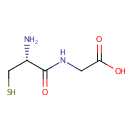| References: |
- Andersson A, Isaksson A, Brattstrom L, Hultberg B: Homocysteine and other thiols determined in plasma by HPLC and thiol-specific postcolumn derivatization. Clin Chem. 1993 Aug;39(8):1590-7. Pubmed: 8353942
- Badiou S, Bellet H, Lehmann S, Cristol JP, Jaber S: Elevated plasma cysteinylglycine levels caused by cilastatin-associated antibiotic treatment. Clin Chem Lab Med. 2005;43(3):332-4. Pubmed: 15843241
- Bald E, Glowacki R: Analysis of saliva for glutathione and metabolically related thiols by liquid chromatography with ultraviolet detection. Amino Acids. 2005 Jun;28(4):431-3. Epub 2005 May 20. Pubmed: 15900404
- Duman BS, Ozturk M, Yilmazeri S, Hatemi H: Thiols, malonaldehyde and total antioxidant status in the Turkish patients with type 2 diabetes mellitus. Tohoku J Exp Med. 2003 Nov;201(3):147-55. Pubmed: 14649736
- Ebisch IM, Peters WH, Thomas CM, Wetzels AM, Peer PG, Steegers-Theunissen RP: Homocysteine, glutathione and related thiols affect fertility parameters in the (sub)fertile couple. Hum Reprod. 2006 Jul;21(7):1725-33. Epub 2006 Mar 23. Pubmed: 16556671
- Fiskerstrand T, Refsum H, Kvalheim G, Ueland PM: Homocysteine and other thiols in plasma and urine: automated determination and sample stability. Clin Chem. 1993 Feb;39(2):263-71. Pubmed: 8432015
- Giustarini D, Lorenzini S, Rossi R, Chindamo D, Di Simplicio P, Marcolongo R: Altered thiol pattern in plasma of subjects affected by rheumatoid arthritis. Clin Exp Rheumatol. 2005 Mar-Apr;23(2):205-12. Pubmed: 15895891
- Jacobsen DW, Gatautis VJ, Green R, Robinson K, Savon SR, Secic M, Ji J, Otto JM, Taylor LM Jr: Rapid HPLC determination of total homocysteine and other thiols in serum and plasma: sex differences and correlation with cobalamin and folate concentrations in healthy subjects. Clin Chem. 1994 Jun;40(6):873-81. Pubmed: 8087981
- Josch C, Sies H, Akerboom TP: Hepatic mercapturic acid formation: involvement of cytosolic cysteinylglycine S-conjugate dipeptidase activity. Biochem Pharmacol. 1998 Sep 15;56(6):763-71. Pubmed: 9751082
- Kagedal B, Kallberg M: Cysteinylglycine in urine determined by high-performance liquid chromatography. J Chromatogr. 1984 Jun 8;308:75-82. Pubmed: 6746837
- Kanehisa, M., Goto, S., Sato, Y., Furumichi, M., Tanabe, M. (2012). "KEGG for integration and interpretation of large-scale molecular data sets." Nucleic Acids Res 40:D109-D114. Pubmed: 22080510
- Keseler, I. M., Collado-Vides, J., Santos-Zavaleta, A., Peralta-Gil, M., Gama-Castro, S., Muniz-Rascado, L., Bonavides-Martinez, C., Paley, S., Krummenacker, M., Altman, T., Kaipa, P., Spaulding, A., Pacheco, J., Latendresse, M., Fulcher, C., Sarker, M., Shearer, A. G., Mackie, A., Paulsen, I., Gunsalus, R. P., Karp, P. D. (2011). "EcoCyc: a comprehensive database of Escherichia coli biology." Nucleic Acids Res 39:D583-D590. Pubmed: 21097882
- Mansoor MA, Svardal AM, Ueland PM: Determination of the in vivo redox status of cysteine, cysteinylglycine, homocysteine, and glutathione in human plasma. Anal Biochem. 1992 Feb 1;200(2):218-29. Pubmed: 1632485
- Pastore A, Massoud R, Motti C, Lo Russo A, Fucci G, Cortese C, Federici G: Fully automated assay for total homocysteine, cysteine, cysteinylglycine, glutathione, cysteamine, and 2-mercaptopropionylglycine in plasma and urine. Clin Chem. 1998 Apr;44(4):825-32. Pubmed: 9554495
- Perry TL, Hansen S: Cystinylglycine in plasma: diagnostic relevance for pyroglutamic acidemia, homocystinuria, and phenylketonuria. Clin Chim Acta. 1981 Nov 25;117(1):7-12. Pubmed: 7333014
- Raijmakers MT, Roes EM, Zusterzeel PL, Steegers EA, Peters WH: Thiol status and antioxidant capacity in women with a history of severe pre-eclampsia. BJOG. 2004 Mar;111(3):207-12. Pubmed: 14961880
- Reddy VB, Doss GA, Creighton M, Kochansky CJ, Vincent SH, Franklin RB, Karanam BV: Identification and metabolism of a novel dihydrohydroxy-S-glutathionyl conjugate of a peroxisome proliferator-activated receptor agonist, MK-0767 [(+/-)-5-[(2,4-dioxothiazolidin-5-yl)methyl]-2-methoxy-N-[[(4-trifluoromet hyl) phenyl]methyl]benzamide], in rats. Drug Metab Dispos. 2004 Oct;32(10):1154-61. Epub 2004 Jun 30. Pubmed: 15229171
- Ueland PM, Mansoor MA, Guttormsen AB, Muller F, Aukrust P, Refsum H, Svardal AM: Reduced, oxidized and protein-bound forms of homocysteine and other aminothiols in plasma comprise the redox thiol status--a possible element of the extracellular antioxidant defense system. J Nutr. 1996 Apr;126(4 Suppl):1281S-4S. Pubmed: 8642471
- Van Hove JL, Lazeyras F, Zeisel SH, Bottiglieri T, Hyland K, Charles HC, Gray L, Jaeken J, Kahler SG: One-methyl group metabolism in non-ketotic hyperglycinaemia: mildly elevated cerebrospinal fluid homocysteine levels. J Inherit Metab Dis. 1998 Dec;21(8):799-811. Pubmed: 9870205
- Zappacosta B, Manni A, Persichilli S, Scribano D, Minucci A, Lazzaro D, De Sole P, Giardina B: HPLC analysis of some sulphur compounds in saliva: comparison between healthy subjects and periodontopathic patients. Clin Chim Acta. 2003 Dec;338(1-2):57-60. Pubmed: 14637266
- Zinellu A, Carru C, Galistu F, Usai MF, Pes GM, Baggio G, Federici G, Deiana L: N-methyl-D-glucamine improves the laser-induced fluorescence capillary electrophoresis performance in the total plasma thiols measurement. Electrophoresis. 2003 Aug;24(16):2796-804. Pubmed: 12929176
|
|---|


